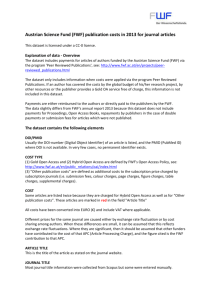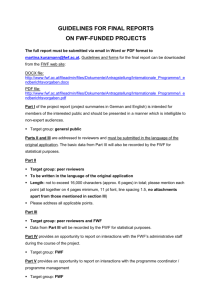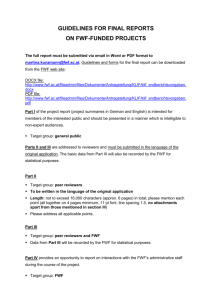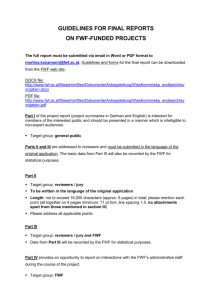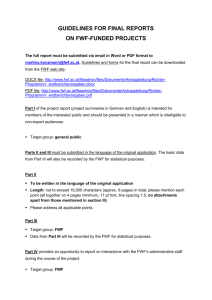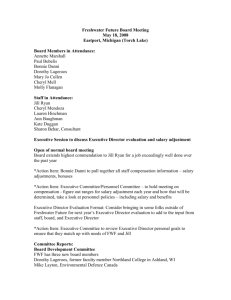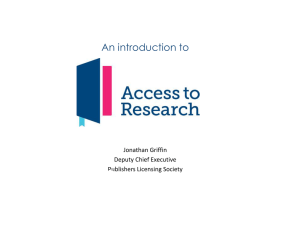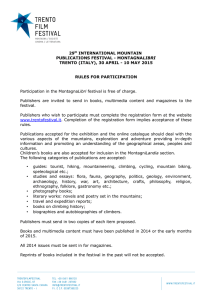FWF Open Access Policy Slides 2015
advertisement
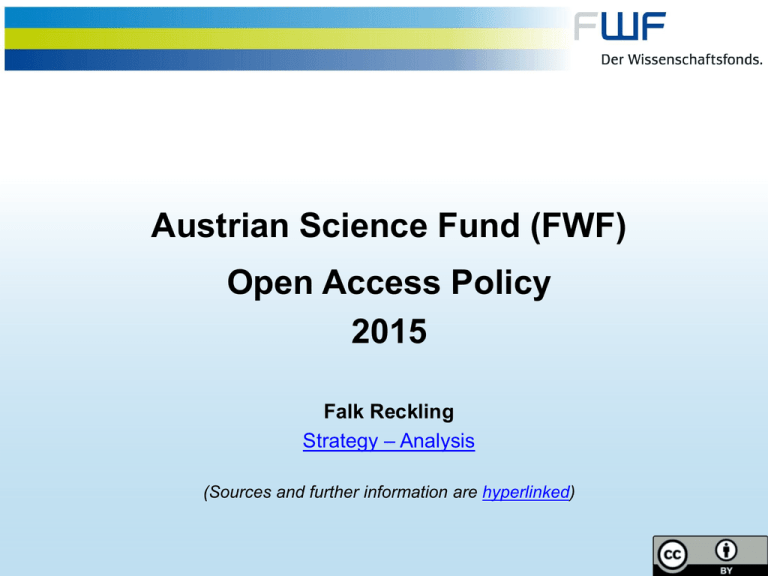
Austrian Science Fund (FWF) Open Access Policy 2015 Falk Reckling Strategy – Analysis (Sources and further information are hyperlinked) Economics of the academic publishing system 2 But it‘s the economy too, stupid ! researchers produce for publishers as authors, editors and reviewers free of charge taxes and fees fund researchers tax payers fund but have only limited access to publications researchers consume publications they have produced publishers produce and advertise publishers sell to libraries 3 Dysfunctional Publication Market every publication is a monopoly and cannot be substituted the price service relation of publications are not transparent for researchers which creates a tragedy-of-commons-problem big publishers sell bundles of journals (big deal) with intransparent pricing (nondisclosure clauses) dominance of some oligopolists with operating profits from 35% to 42% (revenue of ~ Ø $ 4-5.000 per article) publishers hold copyright which are the basis for high profitable value added services (e.g. bibliometric and bibliographic databases) new information giants in science arise Luxury Journal Effect: research careers are often determinated by the branding of the publication venue and not by the publication but see counter movements as the San Francisco Declaration on Research Assessment (signed by the FWF) 4 Price factors of commercial vs. non-commercial academic journals per citation (Source: http://www.journalprices.com/) All 4.75 Social Science 3.33 Psychology 3.01 Physics 5.17 Medicine Mathematics 8.06 2.86 Humanities History Law: 17,55 3.96 2.72 Geology 6.04 Engineering 3.10 Education 4.68 Economics Computer Science 3.36 2.52 Chemistry Business 4.34 3.21 Biology Agriculture 4.62 3.32 5 What is Open Access? 6 What is Open Access? Main Principle free access to scholarly publications and research data via the Internet Author rights Authors hold the copyright and may post any version to any repository or website Reuse all publications shall be published under an open licence, preferably the Creative Commons Attribution CC BY . In any case, the licence applied should fulfill the requirements defined by the Berlin Declaration. Machine Readiblity Publication full text, metadata, supporting data, citations and the status of the publication as Open Access have to be made available in a machine-readable form via open standards. 7 Why Open Access ?* Technical the digitalisation and the Internet offer new publication formats new potentials for searching, cross-linking and filtering of knowledge (e.g. text and data mining) Scholarly improvement of knowledge exchange and higher citation rates better reproducibility of research results reduction of research costs through Open Access Societal economic and moral claim of tax payers new transfer of knowledge into society (e.g. doctors, teachers, SME, journalists, public administration, interested laymen) * see testimonials more than 40 outstanding researchers 8 FWF Scientists Survey 2013 9 State of the Art The two biggest funding agencies in basic research for the Austrian research institutions, the EU (Horizon 2020 + ERC) and the Austrian Science Fund (FWF), require and support all project leaders and project staff members to make their peer-reviewed research results freely available through the Internet. Open Access to research data is recommended but not yet mandated. 10 Carlos Moedas EU Commissioner for Research, Science and Innovation “Public investment in research and innovation should have the greatest social and economic benefits possible: improving the public relationship with our science systems and opening research results to new innovation and business opportunities … Expensive fees for publically funded research results, that could be of benefit to citizens, must end, and new business models put in place … “ 11 International Developments European Commission (July 2012) Recommendation to member states: 60% Open Access in 2016 Danemark (July 2014) 80% Open Access in 2017 and 100% in 2022 Germany (July 2014) the government plans a comprehensive strategy for Open Access and Open Data Sweden (February 2015) 100% Open Access in 2025 UK (March 2014) from 2016 the Research Excellence Framework accepts Open Access publications only + offsetting deals with publishers Netherlands (December 2014) 60% Open Access in 2016 and 100% in 2024 + full OA deals with publishers 12 Open Access Policy and Funding of the FWF 13 Option I: Green Open Access FWF Policy = self-deposition of the author’s accepted manuscript (after peer-review but prior to publishers copy editing and production) in any sustainable subject or institutional repository after a period of no longer than 12 months. almost 700 institutions recommend/require to make publications OA in nearly 4000 repositories more than 1200 publishers allow OA self-archiving of articles published in subscription journals Caveats ! preprints or working papers are not Open Access, only peer-reviewed versions in most cases not the orginial version of record but only the accepted manuscript can be archived different embargo policies (0 to 48 months) with the tendency of extension (see Elsevier) rights for authors and users are still very restricted no influence on publishers pricing policies so far 14 Option II: Gold Open Access FWF Policy = publication in an Open Access venue using the Creative Commons Attribution (CC-BY). Costs are additionally covered by the FWF via the programme Peer-Reviewed Publications up to three years after the end of the project. out of 10.000 OA journals 3.000 are indexed in bibliometric databases + some models for books ~ 65% of OA journals work without author fees. If author fees are requested, Ø € 800 per article but high variance: € 100 - € 4.000 ~ 20% of all indexed articles are Gold Open Access Caveats ! Since most OA journals are very young, they still lack reputation and therefore are unattractive for younger researchers high disciplinary variance of renowned OA journals lack of funding for author fees Discredits by faux journals or predatory publisher 15 20 most used OA journals of FWF funded authors 1. PLOS ONE 11. SCIENTIFIC REPORTS 2. NEW JOURNAL OF PHYSICS 12. 3. OPTICS EXPRESS 13. ATMOSPHERIC CHEMISTRY AND PHYSICS BIOGEOSCIENCES 4. NUCLEIC ACIDS RESEARCH 14. BIOMEDICAL OPTICS EXPRESS 5. PLOS GENETICS 15. 6. PLOS PATHOGENS 16. 7. ANNALES GEOPHYSICAE 17. FRONTIERS IN HUMAN NEUROSCIENCE HYDROLOGY AND EARTH SYSTEM SCIENCES MICROBIAL CELL FACTORIES 8. BMC GENOMICS 18. ACTA CRYSTALLOGRAPHICA E 9. BMC EVOLUTIONARY BIOLOGY 19. 10. ELECTRONIC JOURNAL OF COMBINATORICS 20. ACTA PROTOZOOLOGICA NATURE COMMUNICATION 16 Option III: Hybrid Open Access FWF Policy = payment for OA of a single article in a subscription venue using the Creative Commons Attribution (CC-BY). Costs are additionally covered by the FWF via the programme Peer-Reviewed Publications up to three years after the end of the project. prices per article vary enormously € 900 to € 4.000 Hybrid OA offers publishers a possibility of switching journals from subscription to Open Access Caveats ! „Double Dipping“ despite of official communiques publishers pocket often twice only 2% to 3% of all articles are Hybrid Open Access, only few real transition models from subscription to Open Access exist 17 FWF OA funding in a nutshell 2001: coverage of OA author fees via Peer-Reviewed Publication OA Policy: recommendation since 2004, mandate since 2008 2009: one of the first OA book funding programmes (~ € 1 Mio./year) FWF EBook Library (now 280 OA Books) 2010: funder of Europe PubMedCentral 2013: initiator of the Open Access Network Austria (OANA) 2013: funder of arXiv 2013: co-funder of the Austrian share for SCOAP³ 2013: initial funding of eight journals from social science and humanities 2013: ~ € 3,0 Mio (1.5% of the overall budget) 2014: study Developing an Effective Market for Open Access Article Processing Charges together with Wellcome Trust, Research Councils and others published) 2014: together with the Austrian Library Consortium first offsetting models with IOP Publishing, RCS, Taylor & Francis 18 News in 2015 Publication Costs price caps (Gold Open Access fees = € 2,500 per article, Hybrid Open Access fees = € 1,500 per article) ceases to make additional payments for any publication costs for subscription journals (e.g. colour figures, page charges and submission fees) Offsetting deal for Hybrid Open Access with publisher Taylor & Francis Stand-Alone Publications extension to new digital Open Access publication formats (e.g. apps, wikis, software, databases, audio, video, animation), funding up to € 18,000 Open Research Data Applicants for research grants are explicitly asked to budget funds for processing, archiving and re-using open research data (see 2.6. “Other Costs”) Compliance From 2016 onwards, final reports require that all publications are OA 19 For more informations FWF Open Access Policy FWF Open Access News FWF Open Access on Twitter 20
